新人教版 必修2 unit 3 M2U3-阅读课件-Who am I
人教版新课标高中英语必修2unit3_课件

While-rБайду номын сангаасading(1):skimming
1. Who is the speaker –“I”—in this story? “ I ” am a _c_o_m__p_u_t_e_r_ .
2. What’s the main idea of this passage? A. The development of computers. B. The development and use of computers. C. A machine which is simple-minded. D. Computers may replace human beings.
Quiz 1 True or False
1. My real father was Charles Babbage, who wrote a book and built me in 1936. 2. After I got my new transistors in the 1960s, I became smaller but cleverer and quicker. 3. I was brought into people’s homes in the 1970s. 4. Since my birth I have been built to take the place of the human race.
Many new applications have been found for computers.
Now: Computers connect people all over the world
together.
Look at these inventions. Can you put them in an order according to the time when they appeared? After reading the passage, check to see if you are right.
人教版高一英语必修二unit3 computers (reading)精品课件
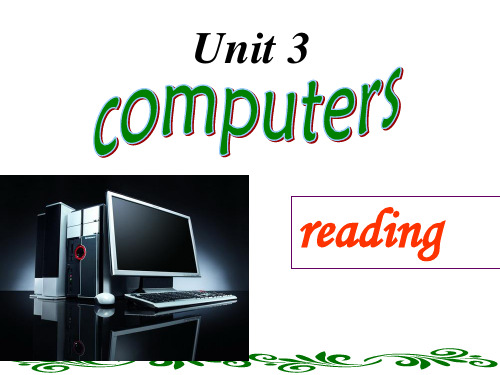
1.I’m also a machine. But I’m small, so you can put me in your pocket. 2.There are ten numbers on me. 3.And you can use me to talk to others even in a far-away place.
While -reading(2): timeline 1642: The computer began as a calculating machine. 1822: The Analytical Machine was built by Charles Babbage.
1936: The computer grew rapidly both in size and
an answer quicker than any person?
2. I totally changed my shape, because 3. Many new applications have been found for me, such as 4. (translation) Over time my memory has . .
While-reading(3):
2.I totally changed my shape, because my memory was first stored in tubes, then on transistors and later on very
small chips.
I totally changed my shape!
Who am I?
computer
Reading
WHO AM I?
While-reading(1):
新人教版高一英语必修二Unit3 Reading(课堂PPT)
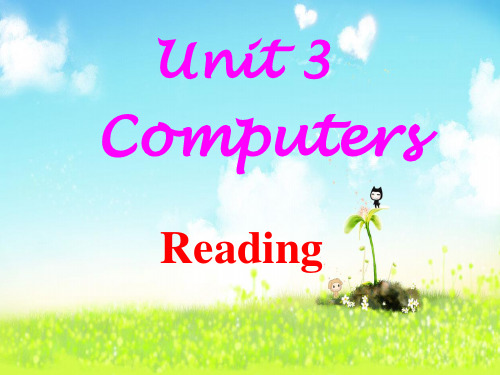
Computers
Reading
1
Learning Aims
1. To learn about something about computers.
2. Reading and understanding, catching the history and information of the passage“who am I ?”.
9
Careful reading
10
Match the main ideas and the paragraphs.
Para 1:
These changes only became possible as my memory
Para 2:
improved. Since the 1970s many new
6. the part of computer that we can put a CD in
screen keyboard mouse monitor DVD-ROM hard disk
5
Reading
WHO AM I?
6
Skimming to get
general ideas
7
Skimming
8
Skimming
Reading Comprehension II
Look at these inventions. Can you put them in an order according to the time when they appeared?
( 2 ) analytical machine ( 5 ) laptop ( 1 ) calculating machine ( 6 ) robot ( 4 ) PC ( 3 ) universal machine
人教版英语必修二Unit 3 Reading(Who Am I?)教学设计

准确把握阅读文章的脉络和写作手法
教学流程:
Steps
Aims
Teacher’s activities
Students’ activities
1.Warming-up: (1min)
To introduce the topic
Go over the topic discussed in the last lesson
4. Post-reading
(5min)
To analyze the writing technique of the passage
Lead Ss toanalyzethe last sentence of the passage &the writing technique of the passage
Give Ss some comprehending tasks and guide them to work them out
Read and work out the comprehending tasks
To teach Ss some skills that can be used to find the topic sentences and summarize the main idea of the paragraphs
Go over the topic
2.Pre-re learn to predict before reading
Show Ss the title of the passage. Guide Ss to predict and help Ss to build up a knowledge net.
Analyze the writing technique of the passage
人教版英语必修二Unit 3(Who Am I?)教案

Learning plan for Senior English Book 2Unit 3 ComputersReading Who am I?Designer :Senior Grade One●Teaching goals1. Language targetImportant words :Calculate universal simplify operator logically reality personal tube network application financeexplore revolution artificial intelligence technological2. Ability goals1)Enable the students to grasp the history of computers.2) the relationship between computers and humans.●Teaching important pointsTry to finish the exercises of Comprehending.●Teaching difficult pointsEnable the students to learn how to grasp the structure of the text.●Teaching proceduresStep I:Greetings and leading-in●Activity1:see a short film about robots (2')●Activity2: Guessing games --word puzzle (class work /5') Let’s guess what they are:● made of wooden beads(珠).●An old calculating machine .● in China until now.Who am I?● solve some mathematical problems.● too big. /as large as a room.Who am I?● a new calculating machine.●can solve a large number of mathematical problems.Who am I?●a kind of computer .● can solve all kinds of problems .●be used widely now.Who am I?● a kind of computer.●can be taken conveniently(便利) like a notebook.Who am I?●Step II. Skimming:Activity3:Do a quizRead and answer these questions: (individual work / 3')1.Who am I?2.Who was the first person to invent the earliest computer?3.Who was the next important person to design computers?4.How old is the computer?5.when was the computer the biggest?6.What happened to the computer in the 1960s?●Step III. ScanningTask1: Read the passage again and complete the chart below(Pair work /5’)Task2:Read the passage and finish the timeline below (individual work / 3’)1642: The computer began as a .1822: The analytical machine was made by Charles Babbage.____ : The computer grew both in size andin .1940s : The computer had grown a room.: The first family of computers was connected to each other. 1970s :computers were used in .Now : Computers connect people . together.Task3:Check the sentences are true or false. (individual work / 3')1.Alan Turing built an Analytical Machine to solve any mathematical problems.( )2.People began to realize that the computer got cleverer and quicker with time passing.( )3.The computer began to serve the human race since it was brought into people’s homes.( )4.Since the 1970s, the computer was used by people around the world through the Internet.( )●Step IV.Summary(class work /5')I began as a ________ ________ in 1642 . In 1822 I was built as an ________ _________. In 1936 Alan Turing built a _______ ________. As the years have____ ____, I have been made_____ and smaller, but I got ____ ____ cleverer , quicker ____ _____.In the 1960s they gave me a family________ ___ .I was _____ ____ ____ ______ in the 1970s. Since my birth I have truly been built to serve the human race.Step V.Activity 4: Discussion( group work /5')Discuss with your partners to list some advantages and disadvantages of the Internet.Advantages:___________________________________________ Disadvantages:__________________________________________ ●HomeworkWrite a composition about the relationship between human race and the computer .。
人教版高中英语必修2 Unit3 Reading精品课件
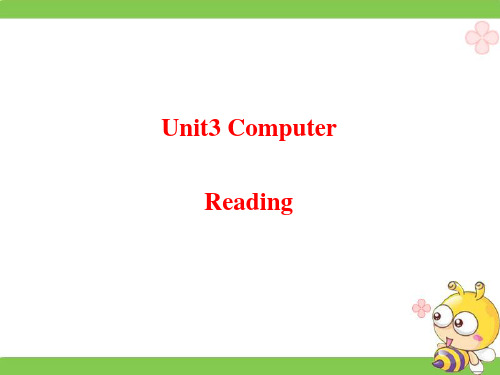
2) What can you infer from the text? A. The computer has artificial intelligence. B. The computer changes a lot over the years. C. The computer was not connected by a network until in the early 1960s. D. Now the computer can only be used to deal with information.
Do you know who I am?
abacus
I am very small. I can be used for calculating. In China, a lot of students use me when solving mathematical problems. Do you know who I am?
since it was brought into people’s homes. F
4. Spienocpelethaero1u9n7d0st,htehewcoormldptuhtreoruwghasthueseIdntbeyrneTt.
5. The larger the computer is, the more memory
calculator
I can be used for calculating. Besides, I can also be used for watching DVD, sending e-mail and communicating through the Internet. However, I am not a PC, because I’m small enough for you to take me with you. Do you know who I am?
人教版高中英语 必修二 Unit3 Computers Reading 课件

1.They can be used for calculating. 2.They can deal with math problems. 3.They are our friends. 4.They are useful and helpful.
search for information see movies
Fill in the chart wIithhaIvtthewecahsiancnfogonersdmidaaerltoieotdnain para 1.
tfercohmnoalocaglicualarteivnoglution
mmaacchhaciarinannteiledfc.itucotIihlacaaelantsinintanadtnegroaltllmioygfteaitnchacyele. Simplify
Let’s play a guessing game!
ks5u
Riddles(谜语):
I am very old now. I was born in China. Many people used me for calculating in the past, but now I am a bit lonely because they don’t like me now.
人教版必修二 高中 Unit 3 阅读 Who am I 试讲稿

人教版必修二高中Unit 3 阅读Who am I?试讲稿Good morning/afternoon, dear judges, I am No. ____ Candidate. Applying for senior high school English teacher. Today, my topic is “Who am I?”. Now, please allow me to start my presentation.Good morning/afternoon, everyone, are you happy today? That's great, I'm glad you feel happy. I can't wait to have our English journey! Now, everyone, let's have a brainstorm, say as much as you can. How many digital products do you know? Hurry up, think about it! Oh, yes, we have phones. And? Computers, good. What's more? Digital camera. That's one of it....(可根据试讲时间适当增减)You did a good job. Now, please look at the pictures and title on page 18. Can you guess “who am I”? Who is the narrator of the article? Linda, you please. You don't know? It's ok. How about you, George? Maybe computer? Yes, the narrator is the computer, so “I”am the computer.Speaking of computers, what do you know about them? And how have computers changed our lives? You may discuss with your group members. And I will give you five minutes. After that, please share your answers to us.Ok, now, times up! Who can share your results? The first question, what do you know about computers? Mary, can you? Good. Anything else? Ken, you please. Well done, Ken!How about the second question, how have computers changed our lives? Katherine, I see you put up your hand. Good, please sit down. And let's invite Peter to share his answer. That's good, thumbs-up for all of you!1) Skimming: Guide students to skim the text and find out the main idea of it. Ask the students what is the order of the passage.2) Scanning: Provide students a timetable to scan the text and fill the blanks of the table to get more detailed information.3) Careful reading: Students can finish the multiple choices and fill in the blanks given by the teacher.Now, let's find out what the passage is about! I'll give you three minutes to skim the passage, and then, please tell me what is the main idea of the passage and what is the order of the passage.Ok, now, please tell me together, what is the passage mainly about? Yes, it's about the development of computers. And do you find out what is the order of the passage? It's according to? Good, you've got it. It's according to time order.Now, look at the screen, we have a timetable. And some important information are missing in the table. Can you help us to fill in the blanks? Five minutes for you!Ok, stop here. Who can tell us the answers? Ok, you please, Helen. Great, any different ideas? William, please. Right, it should be “Alan Turing wrote a book to descrie how computers could be made to work”in 1936. Now, do you agree with their answers? You did? Good!Look at the screen, there are some multiple choices, and another passage with some blanks. This time I'll leave you six minutes to find the answers. You can ask me for some help, or you can discuss it with your deskmates.Let's check the answers now, together, the first one is? Good, it's A. And the second one.Be careful, it should be C, not B, ok? And each one each blank, start from you, please. Well done! You've got the answers!It's time for your imagination. What do you think computers will be in the future? You can discuss it with your group members, and write down some interesting things on your paper. Four minutes for you! Here we go!Group one, what do you think! Wow, that's fascinating! Group two, how about your ideas? Artificial intelligence, you've catch the trend. Group three? Maybe closely related to our health! Excellent, you really have some good ideas!Now, Eric, may I ask you to summarize what we've learnt today? Yeah, we have learned a passage about the development of computers. We have also learned the writing in the first-person perspective. It's very useful, right? You can use it in your writing.Did you enjoy our English journey? That's great! (情感升华)Remember to use English in our daily lives, ok? Now, here comes your homework. After class, search the Internet for some information of the development of phones and write a short passage just like we have learned today. Would you like to do it? That's so good. Next class, you can show your results. So much for today, see you next time.That's all, thanks for your listening.。
新人教版高中英语必修二 Unit 3 Reading教学课件

1642 The computer began as a calculating machine. 1822 The analytical machine was made by Charles Babbage. 1936 The computer grew rapidly both in size and in brainpower.
B. The computer changes greatly
over the years.
C. The computer was not connected by
a network until in the early 1960s. D. Now the computer can only be used to deal with information.
( 2 ) analytical machine ( 5 ) laptop ( 1 ) calculating machine ( 6 ) robot ( 4 ) PC ( 3 ) universal machine
Reading
Go over the story to find out who the speaker is. Write down 3 sentences to support your idea.
7. What happened to the computer in the 1960s? B A. It was put into robots and used to make mobile phone. B. It was given a family connected by a network. C. It began to be put into space rockets D. It began to be used in the offices.
人教版高中英语必修2 Unit3 Workbook-Reading 精品课件

Heavy!
Difficult!
Hard!
Tired!
Easy!
Fast! Free!
keyboard
mouse speaker
monitor
modem
scanner hard disc printer USB flash disc
Label each part.
monitor 1 hard disk
2 6
screen
3 CD-ROM
5
mouse
4
keyboard
1. Look at these pictures. In pairs discuss what they have in common. 2. What do they tell you about the development of computers? 3. What do you think will be the next development?
1. Where were you in 1642?
In France. 2. What happened to you after nearly two hundred years? I was built as an Analytical Machine by Babbage.
3. What were you called in 1936?
1822 The analytical machine was
1936
The computer grew rapidly both in size and in brainpower.
Computers had grown as large as 1940s a room. The first family of computers was 1960s connected to each other.
人教版高中英语必修二 Unit 3 Reading课件
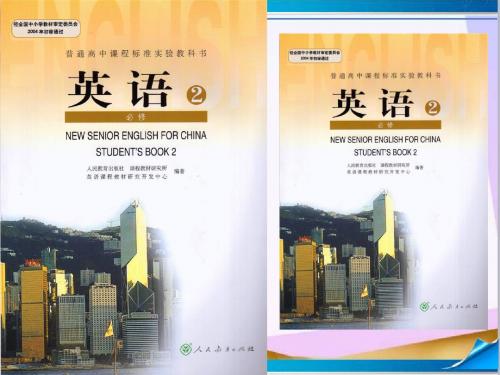
1940s The computers had grown as large as a room. The first family of computers 1960s was connected to each other. 1970s Computers were used in offices and homes. now Computers connect people all over the world together.
Look at these inventions. Can you put them in an order according to the time when they appeared? After reading the passage, check to see if you were right.
人教新课标高中英语必修二 Unit 1 Cultural relics Unit 2 The Olympic Games Unit 3 Computers Unit 4 Wildlife protection Unit 5 Music
Unit 3
Computers
Reading
Pre-reading
Fast-reading 1. Who am I ? I am a computer. 2. Who built the first analytical machine? Charles Babbage built the first analytical machine. 3. Who was the next important person to design computers? Alan Turing was the next important person to design computers.
人教版高中英语 必修二 Unit3 《Computers ---Reading》 课件 (共32张PPT)
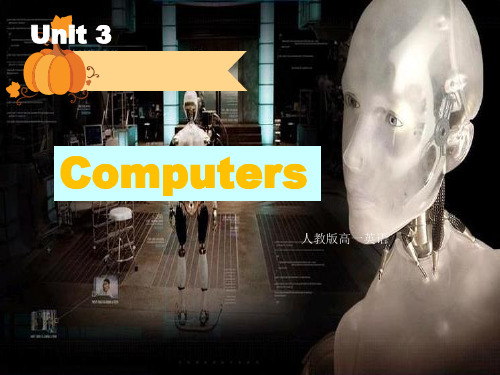
3 trade
4 robots 5 mobile phones 6 medical operations 7 space rockets
8 providing a life of high quality
Careful reading
Reading Comprehension Finish the timeline below.
abacus
I can be used for calculating. Besides, I can also be used for watching DVD, sending e-mail and communicating through the Internet. However, I am not a PC, because I’m small enough for you to take me with you. Do you know who I am?
PDA
Personal Digital Assistant
I am very small. I can be used for calculating. In China, a lot of students use me when solving mathematical problems. Do you know who I am?
_a_n_a_ly_t_i_ca_l_ m__a_c_h_i_n_e_. Then in 1936 Alan Turing wrote a book and built a _u_n_i_v_e_rs_a_l _m_a_c_h_i_n_e_. As the years have gone by, I have been made _sm__a_l_le_r_ and _s_m__a_ll_e_r_ but I became __cl_e_v_e_r_e_r_ and _q_u__ic_k_e_r__.
- 1、下载文档前请自行甄别文档内容的完整性,平台不提供额外的编辑、内容补充、找答案等附加服务。
- 2、"仅部分预览"的文档,不可在线预览部分如存在完整性等问题,可反馈申请退款(可完整预览的文档不适用该条件!)。
- 3、如文档侵犯您的权益,请联系客服反馈,我们会尽快为您处理(人工客服工作时间:9:00-18:30)。
Guess!
A handbag?
A toy?
Guess more:
I am very old now. I was born in China. Many people used me for calculating in the past, but now I am a bit lonely because they don’t like me now.
1 A monitor is
(a) the part of a computer that stores information. (b) the part of the computer that you type on. (c) the part of the computer that looks like a television (d) something you use to click on things (files, etc.). (e) the part of the monitor that you look at. (f) a separate disk that contains lots of information.
• Speed: quicker
• Function: calculating----dealing with …, communicating with… • People’ opinion: clever & useful
Match the words with their meanings.
school work
games
emails
music and films chat
information
photos
shopping
convenient laptop
smaller desktop
palmtop
What about in the future?
robot
2 The screen is
3 A keyboard is 4 A mouse is 5 A CD-ROM is
6 A hard disk is
Consolidation: Retelling
1642 1822 1936 1940s 1960s 1970s now began … calculating …France The Analytical Machine … Charles Babbage Alan Turing … wrote … built … As large as connected … share … talk … Become very important in … deal with … communicate …
● I was able to share my knowledge with others through the World Wide Web.
Scanning:
1642
Timeline
The computer began as a calculating machine. The Analytical Machine was made by Charles Babbage. Alan Turing wrote a book to describe how computers could be made to work.
Do you know who I am?
abacus
I am very small. I can be used for calculating. In China, a lot of students use me when solving mathematical problems.
Do you know who I am?
calcur calculating. Besides, I can also be used for watching DVD, sending e-mail and communicating through the Internet. However, I am not a PC, because I’m small enough for you to take me with you.
北
京
信
息
工
程
学
院
附
属
中
学
Unit 3 Computers
Reading: Who am I?
Words and Phrases
solve v. 解决;解答 from … on… 从….时起 reality n. 真实;事实;现实 as a result 结果 total adj. 总的;整个的 n. 总数 so … that 如此…. 以致于 explore v. 探索;探测;探究 anyhow adv. 无论如何,即便如此 goal n. 目标 human race 人类 signal v. 发出信号 n. 信号 type n. 类型 v. 打字 in a way 在某种程度上 arise (arose, arisen) 出现,发生 with the help of 在…帮助下 electronic adj.电子的 deal with 处理;安排;对付 watch over 看守;监视
True or False
1. Alan Turing built an Analytical Machine to F solve any mathematical problems. 2. People began to realize that the computer got T cleverer and quicker with time passing. 3. The computer began to serve the human race F since it was brought into people’s homes. 4. Since the 1970s, the computer was used by T people around the world through the Internet. 5. The larger the computer is, the more memory F it has.
Do you know who I am? notebook computer
A huge computer
Palmtop
A PC
Who am I ?
Skimming:
Go over the story to find out who the speaker is. Write down 3 sentences to support your idea. It is a computer. ● I was built as an Analytical Machine by Charles Babbage.” ●”My real father was Alan Turing ....”
2) What can you infer from the text? A. The computer has artificial intelligence. B. The computer changes a lot over the years. C. The computer was not connected by a network until in the early 1960s. D. Now the computer can only be used to deal with information.
1822
1936 1940s In
which order is the as large organized? Computers had grown text as a room.
1960s
1970s now
The first family of computers was connected to each other. Computers were used in offices and homes. Computers connect people all over the world together.
2. Questions
Q1: How did the computer work as an Analytical Machine? The computer followed instructions from cards with holes.
Q2: In how many ways do we say the computer changed? What are they? • Size: smaller • Intelligence: cleverer
Comprehending:
1. Choose the best answers
1) What’s the main idea of the text? A. The computer wants to find “who he is”. B. The functional change of the computer. C. The computer becomes popular around the world. D. The history of the computer.
